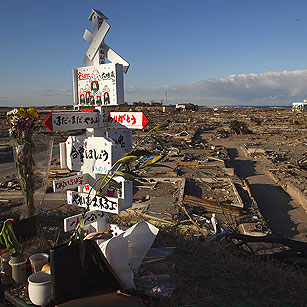
Flying to Niigata, a northern Japanese city not far from the earthquake zone I was covering, I opened the All Nippon Airways in-flight magazine and read an article in Japanese. It was a multipage ode to the rakkyo, a Japanese shallot that is usually eaten pickled. The story detailed the laborious planting, harvesting, cleaning and pickling that the little onions go through. My grandmother used to pickle her own rakkyo, and reading the article made me think back to the red plastic bucket full of brine and pungent bulbs that she kept under her sink. It also occurred to me that for non-Japanese an entire article in a major in-flight magazine on pickled alliums might seem a very strange thing.
In Japan, though, food is fetishized. The obsession has to do, in part, with Japan’s traditional reverence toward nature. Many Japanese surnames are made up of landscape-based characters, like mori , yama , ishi and matsu . The national religion, Shinto, is based on nature worship. The earth’s bounty in the form of food is duly revered too. In that context, a loving article on the life and times of the rakkyo makes perfect sense.
Now, though, Japan is swathed in cement. Riverbeds are made of concrete and mountain faces are encased in man-made materials, while massive pylons stalk the coast. Part of the cement fixation is due to a doomed, recessionary attempt to stimulate the economy through construction projects. Another part is an understandable urge to gird the nation against the vagaries of earthquakes, landslides, typhoons and other natural calamities. Hence all the seawalls and landslide barriers. Safety trumps splendor.
Tohoku, the region of Japan that was devastated most by the earthquake, was one of the few places that still looked like the Japan of yesteryear: little houses and fishing boats crowding coves like scenes out of woodblock prints. But even there, in places where Tokyo residents would go to rediscover man living among nature, seawalls often obscured views of the ocean. Beyond the charming holiday veneer, some of these coastal towns were just the usual blur of convenience stores, pachinko parlors and 100-yen shops. Rural Japan, the place of myth where farmers lovingly plucked rakkyo out of the soil or massaged beer-fed cattle, was dying even before the tsunami swept many of these villages into oblivion. Its residents tended to be old and tired. Growing vegetables in modern Japan was not an easy life, which explains why some Tohoku residents eagerly jumped at the opportunity to profit from putting nuclear power plants amid their paddy fields. That uneasy balancing of technology and nature has been thrown into even sharper relief by the events of March 11: twin natural disasters that triggered a thoroughly modern, radiation-tinged crisis.
Nevertheless, the Japanese spin on a Thoreau idyll lives on, whether in the minds of harried Tokyo residents or foreigners taken with haiku about ponds and frogs and water. In a country where technology has timed to the millisecond everything from train arrivals to toilet flushes, the unpredictability of nature, with its mercurial seasons or weather patterns, can seem like a reprieve. And even if it is not always welcomed, nature will still inflict itself on a country that has tried in vain to rise above it. As terrible as the Tohoku earthquake was, geologists are predicting that an even worse temblor will one day hit Tokyo. When will nature ravage the world’s largest temple to technology? No one knows. What’s certain is that while nature can be revered, it cannot be controlled.